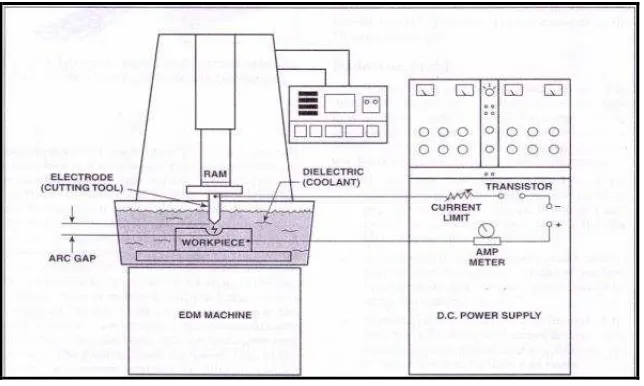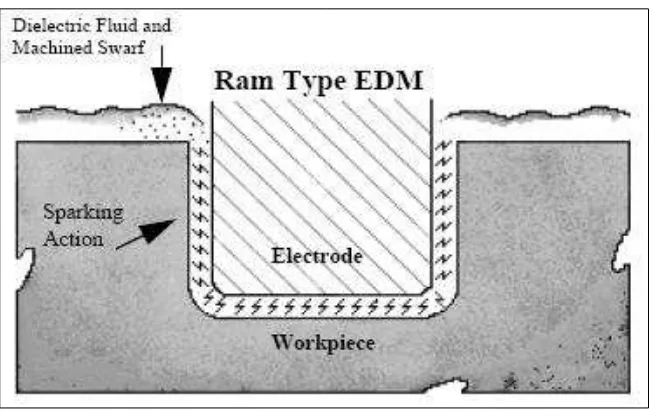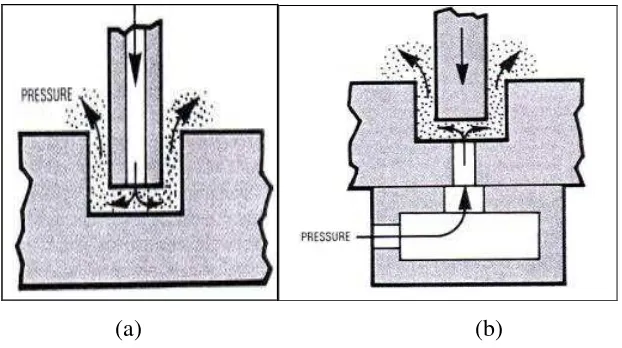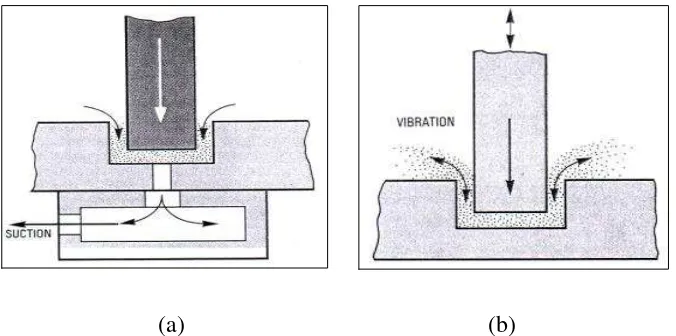UNIVERSITI TEKNIKAL MALAYSIA MELAKA
EDM Performances of Copper Electrode on
Different Materials
Thesis submitted in accordance with the partial requirements of the
Universiti Teknikal Malaysia Melaka for the
Bachelor of Manufacturing Engineering (Manufacturing Process) with
honours.
By
Mohd Ashraf B. Abd Kadir
Faculty of Manufacturing Engineering
UTeM Library (Pind.1/2007)
SULIT
TERHAD
TIDAK TERHAD
(Mengandungi maklumat yang berdarjah keselamatan atau kepentingan Malaysia yang termaktub di dalam AKTA RAHSIA RASMI 1972)
* Tesis dimaksudkan sebagai tesis bagi Ijazah Doktor Falsafah dan Sarjana secara penyelidikan, atau disertasi bagi pengajian secara kerja kursus dan penyelidikan, atau Laporan Projek Sarjana Muda (PSM).
BORANG PENGESAHAN STATUS TESIS*
UNIVERSITI TEKNIKAL MALAYSIA MELAKA
JUDUL:
SESI PENGAJIAN: 2007/2008
Saya _____________________________________________________________________
mengaku membenarkan tesis (PSM/Sarjana/Doktor Falsafah) ini disimpan di Perpustakaan Universiti Teknikal Malaysia Melaka (UTeM) dengan syarat-syarat kegunaan seperti berikut:
1. Tesis adalah hak milik Universiti Teknikal Malaysia Melaka.
2. Perpustakaan Universiti Teknikal Malaysia Melaka dibenarkan membuat salinan untuk tujuan pengajian sahaja.
3. Perpustakaan dibenarkan membuat salinan tesis ini sebagai bahan pertukaran antara institusi pengajian tinggi.
4. **Sila tandakan (√)
MOHD ASHRAF B. ABD KADIR
DECLARATION
I hereby, declare this thesis entitled “EDM Performance of Copper
Electrode on Different Materials” is the result of my own research except
as cited in the references.
Signature : ……….
Author’s Name : Mohd Ashraf B Abd Kadir
APPROVAL
This thesis submitted to the senate of UTeM and has been accepted as partial fulfilment of the requirements for the degree of Bachelor of
Manufacturing (Manufacturing Process).
The members of the supervisory committee are as follow:
………
ABSTRACT
In recent years, remarkable developments have been made in die-sinking EDM, with its application broadening into new fields. It is necessary to considered surface finish and dimensional accuracy to accomplished high precision machining.
The main objective of this project is to find the effect of surface roughness and dimensional accuracy on three different materials which are tool steel (AISI D2), aluminum alloy 6063 and carbon steel (AISI 1045). The variable parameter used is pulse on-time (5µs, 10µs, 15µs, 20µs, 25µs, 30µs, 35µs and 40µs). These three materials will be machined by using 4 pieces of copper electrode.
ABSTRAK
Dalam beberapa tahun kini, perkembangan yang luar biasa telah berlaku pada aplikasi penggunaan mesin nyahcas electrik yang membawa pengembangan dalam bidang baru. Adalah perlu untuk mengambil kira factor kekasaran permukaan dan ketepatan dimenesi ukuran untuk menyempurnakan permesinan berkepersisan tinggi.
Objektif utama untuk projek tahun akhir ini adalah untuk mencari kesan tahap kekasaran permukaan dan ketepatan dimensi ukuran pada tiga material besi yang berbeza seperti besi alatan bergred AISI D2, besi campuran aluminum 6063 dan besi carbon bergred AISI 1045. Parameter berbagai yang digunakan dalam eksperimen ini adalah “pulse on-time” (5µs, 10µs, 15µs, 20µs, 25µs, 30µs, 35µs and 40µs). Ketiga-tiga material akan di mesin dengan menggunakan 4 batang elektrod kuprum.
DEDICATION
ACKNOWLEDGEMENT
Alhamdullilah, Praise to Allah the Most Gracious, the Most Merciful, who’s blessing
and guidance have helped me through my final year project successfully.
First of all, I would like to express my sincere gratitude to my supervisor Mr. Abdul Halim Hakim B. Abdul Aziz, who has conducting and giving an opportunity to complete my final year project. A thousand of thanks I would like to convey especially to Mr. Jaafar who been supervised and helped me during my project session and all others laboratory stuffs.
Last but not least, my deepest gratitude to the most important person in my life, my lovely parents, Hj. Abd. Kadir Basiran and Hjh. Robiah Ahmad for giving me an inspiration and always been there when I needed them. Thank you.
TABLE OF CONTENTS
List Of Abbreviations, Symbols, Specialized Nomenclature………... x
2.4.2 Material of Workpiece……….. 14
4.1 Result and analysis of Surface Roughness and dimensional accuracy….. 34
4.1.1 Surface roughness data………. 35
4.1.1.1 Carbon steel (AISI 1045)………... 36
4.1.1.2 Tool steel (AISI D2)………... 38
4.1.2 Dimensional accuracy………... 4.1.2.1 Carbon steel (AISI 1045)………...
39 39
4.1.2.2 Tool steel (AISI D2)………... 41
4.1.2.3 Aluminum alloy 6063………. 42
4.1.3 Combination result of different materials……… 44
4.1.4 Machining time……… 46
4.1.4.1 Carbon steel (AISI 1045)………... 46
4.1.4.2 Tool steel (AISI D2)………... 47
4.1.4.3 Aluminum alloy……….. 47
4.2 Discussion………... 48
5. CONCLUSION AND RECOMMENDATION………... 51
5.1 Conclusion………. 51
5.2 Recommendation……… 52
REFERENCE……….... 53
APPENDICES
Appendix A- Gantt chart
LIST OF FIGURES
2.1 Ram-type EDMs plunge a tool, shape to the form of the cavity required, into a workpiece.
5
2.2 Control spark removes metal during electrical discharge machining. 7 2.3 (a) Down through the electrode (b) Up through the workpiece 9
2.4 (a) By vacuum flow. (b) By vibration. 10
2.5 Heat-affected zones in EDM 19
2.6 The arithmetic mean value. 20
2.7 Coordinate used for surface roughness. 21
2.8 Mathematical calculation of overcut 22
3.1 EDM die sinking Sodick AQ35L Series 24
3.2 Copper electrode with specific dimension 27
3.3 Copper electrode used in the experiment 27
3.4 Portable Surface Roughness Tester (Mitutoyo SJ 301) 29
3.5 Mitutoyo tool maker’s microscope 29
3.6 Flow chart of the project methodology 33
4.1 Graph of pulse on-time vs. surface roughness for carbon steel (AISI 1045).
35
4.2 Graph of pulse on-time vs. surface roughness for tool steel (AISI D2). 37 4.3 Graph of pulse on-time vs. surface roughness for aluminum alloy 6063. 38 4.4 Graph of pulse on-time vs. dimension overcut for carbon steel (AISI
1045)
40
4.5 Graph of pulse on-time vs. dimension overcut for tool steel (AISI D2). 41 4.6 Graph of pulse on-time vs. dimension overcut for Aluminum alloy
6063.
43
LIST OF TABLES
2.1 The physical properties of copper electrode. 14
2.2 AISI D2 steel composition. 15
2.3 Mechanical Properties of AISI D2 15
2.4 Thermal Properties of AISI D2 15
2.5 Aluminum alloy 6063 composition 16
2.6 Typical Physical/Mechanical Properties of aluminum alloy 6063 17
2.7 Composition of Carbon steel AISI 1045 17
2.8 Mechanical Properties of AISI 1045 18
2.9 Thermal Properties of AISI 1045 18
3.1 EDM die sinking Sodick LN2/LQ Series Specification 25 4.1 Data of surface Roughness (Ra) Test for carbon steel (AISI 1045). 35
4.2 Data of surface Roughness (Ra) Test for tool steel (AISI D2). 36
4.3 Data of surface Roughness (Ra) Test for aluminum alloy 6063 38
4.4 Data of dimensional overcut for carbon steel (AISI 1045). 39 4.5 Data of dimensional overcut for tool steel (AISI D2). 41 4.6 Data of dimensional overcut for aluminum alloy 6063. 42
4.7 Machining Time of carbon steel. 46
4.8 Machining time of D2 steel. 47
CHAPTER 1
INTRODUCTION
1.1 Background
The Electrical discharge machining (EDM) is a non-traditional concept of machining which has been widely used to produce dies and molds. It is also used for finishing parts for aerospace and automotive industry and surgical components. Electrical discharge machining (EDM) is a well-established machining option for manufacturing geometrically complex or hard material parts that are extremely difficult-to-machine by conventional machining processes.
The recent developments in the field of EDM have progressed due to the growing application of EDM process and the challenges being faced by the modern manufacturing industries, from the development of new materials that are hard and difficult-to-machine such as tool steels, composites, ceramics, super alloys, hastalloy, nitralloy, waspalloy, nemonics, carbides, stainless steels, heat resistant steel and etc. being widely used in die and mould making industries requiring high precision, complex shapes and high surface finish (Shankar et al. 2003). In order to find advance materials such as super alloy, ceramic and metal matrix composite, the cost expenditure for these materials is too high. As a result, there are three materials were concerned for this research. The materials are tool steel (AISI D2), aluminum alloy 6063 and carbon steel (AISI 1045).
to produce optimum surface quality. It was noticed that various machining parameters influenced surface roughness and setting possible combination of these parameters was difficult to produce optimum surface quality. The influences of some machining parameters such as pulsed current, pulse time, pulse pause time, voltage, dielectric liquid pressure and electrode material have been examined. One study examined P20 tool steel and provided useful information the effects of some machining parameters on surface roughness, but the selected of pulsed current values was very low 1–8A. (Kiyak & Cakir, 2007). Hence, this research will concerned the same parameter used instead of higher pulse current values.
1.1 Problem Statement
Most of the previous research about EDM die-sinker is emphasizing on the variety of EDM parameter to optimize the parameter value in order to determine the machining performances. With awareness of producing high quality product, this project is focusing on the effect of different material machined on surface roughness and dimensional accuracy. In order to find advance materials such as super alloy, ceramic and metal matrix composite, the cost expenditure for these materials is too high. As a result, there are three materials were concerned for this research on the machining performances. The materials are tool steel (AISI D2), aluminum alloy 6063 and carbon steel (AISI 1045).
1.2 Objectives
Those objectives evaluated are to assist and complete this project:
i. To determine surface roughness by using surface roughness tester for each materials.
ii. To determine dimensional accuracy by using toolmaker’s microscope for each materials.
iii. To analyze the surface roughness and dimensional accuracy on three different materials.
1.3 Scope
CHAPTER 2
LITERATURE REVIEW
2.1 Overview
This chapter will briefly introduce the literature research of this project. It is consisted of the EDM machine, process parameter, material selection and EDM performance measurement.
2.2 Die-Sinker EDM
The earliest EDM equipment was design to make the cavities in dies by letting the electrode work its way straight down into the metal block until the desire depth was archive. These early machine were therefore called die-sinking or plunge EDM machines. Since the vertical position of the electrode was controlled by a hydraulic ram, there are also called ram EDM machine (Adnan, 2002).
Die sinker or sinker EDM is a common name for vertical EDM. This process was called sinking, a die or die sinking, so the term “sinker” for EDM evolved naturally because an electrode was sunk into the workpiece (Bud, 1997).
gap is small enough so that the impressed voltage is great enough to ionize the dielectric. Short duration discharges are generated in a liquid dielectric gap, which separates tool and work piece. The material is removed with the erosive effect of the electrical discharges from tool and work piece. EDM does not make direct contact between the electrode and the work piece where it can eliminate mechanical stresses chatter and vibration problems during machining. Materials of any hardness can be cut as long as the material can conduct electricity. EDM techniques have developed in many areas. Trends on activities carried out by researchers depend on the interest of the researchers and the availability of the technology (Abbas et al. 2005).
The die sinking EDM, Figure 2.1 has a cutting tool (electrode) shaped to the form of the cavity, mounted in the ram of machines. The electrically conductive workpiece is fastened to the machine table below the electrode. The DC power supply produces a series of short, high-frequency electrical arc discharge between the electrode and the workpiece. This action removes (erodes) tiny particle of metal from the workpiece and as the process continues, the electrode reproduces its form in the workpiece (Krar et al. 1998).
2.2.1 A Review of Current Research of EDM Die-Sinker
Electrical discharge machining (EDM) is a well-established machining option for manufacturing geometrically complex or hard material parts. There are various types of products which can be produced using EDM such as dies and moulds. Parts of aerospace, automotive industry and surgical components can be finished by EDM. According to Abbas et al. 2006, the current research trends are in EDM on ultrasonic vibration, dry EDM machining, EDM with powder additives, EDM in water and modeling technique in predicting EDM performances.
In recent years, EDM researchers have explored a number of ways to improve the sparking efficiency including some unique experimental concepts that depart from the EDM traditional sparking phenomenon. Despite a range of different approaches, this new research shares the same objectives of achieving more efficient metal removal coupled with a reduction in tool wear and improved surface quality (Ho & Newman, 2003).
In EDM, commonly copper and graphite tools are used as electrodes. But high tool wear is the major drawback of these electrodes for prolonged machining. According to Khanra et al. (2006) state that research is going on to develop a tool material for EDM, which has a high electrical and thermal resistance, high wear resistance and easy fabricability and availability. Many researchers are trying to develop composites material as an EDM tool material by powder metallurgy route.
2.2.2 Basic Principles of EDM Die-Sinking
connect the workpiece and electrode. Initially, no current flow because the dielectric fluid between the tool and work is an insulator. When the power is on, the potential different is applied to the workpiece and tool electrode. Then, the gap between the tool and workpiece become closer. Sparks contributing jump across the gap from electrode to the workpiece. The molten metal on the surface of the material evaporates explosively, forming a small crater (Krar et al. 1998). The material is removed with the erosive effect of the electrical discharges from tool and work piece. (Abbas et al. 2005). Figure 2.2 shows the debris particles are washing away by dielectric fluid. The process keeps repeating many times per second. Another important aspect for the basic operation fro EDM are dielectric fluid and the flushing technique.
2.2.2.1 Die Electric Fluid
Oils have been used as dielectric fluid as long as the process has existed, but only in the past decade have any appreciable researches or scientific approaches been made as to their composition and compatibility with people and the environment. There are many different types of fluid available. Typically, fluids with parrafinic, napthenic and aromatic bases are used (Bud G.E, 1997).
According to Krar, et al. (1998), the workpiece and the electrode are submerged in the electric oil, an electrical insulator that helps to control the arc discharge. The oil also acts as a coolant, and is pumped through the arc gap to wash away the chips (swarf). A die electric fluid performs three important functions:
i. It insulated the electrode /workpiece gap and prevents a spark from forming until the gap and voltage are correct. When this happens, the oil ionizes and allows the discharge to occur.
ii. It must cool the work, the electrode, and the molten metal particles. Without coolant, the electrode and the workpiece would become dangerously hot. iii. It must flush the metal particles out of the gap. Poor flushing will cause
erratic metal removal, poor machining conditions, and increase machining time and cost.
For most EDM operation, kerosene is the common dielectric used with certain addictives that prevent gas bubble and deodorant. Silicon fluids and mixture of these fluids with petroleum oils have excellent results. Other dielectric fluids such as aqueous solution of ethylene glycol, water in emulsion and distilled water.
2.2.2.2 Flushing
Flushing is the process of introducing clean dielectric fluid into and through the spark gap. This serve several purposes in introduce “fresh” dielectric to the cut, flushes away the “chips” and debris from the spark gap and cools the electrode and workpiece. According to Bud G.E, 1997, on EDM Handbook, there are three type of flushing. There are as follows.
a) Pressure
This is the most common type of flushing; it is also often referred to as injection flushing. The oil is forced through the spark gap, either through holes, Figure 2.5(a), in the electrode or from holes in the workpiece it self , Figure 2.5(b),
(a) (b)
b) Suction
Suction is opposite of pressure suction. The electrode and workpiece are prepared in the same manner as pressure flushing situations, but instead of the oil being “pushed” through the gap, it is “pulled” through vacuum, Figure 2.4 (a).
(a) (b)
Figure 2.4: (a) By vacuum flow. (b) By vibration. (Bud G.E, 1997)
c) Jet or side or vibration



